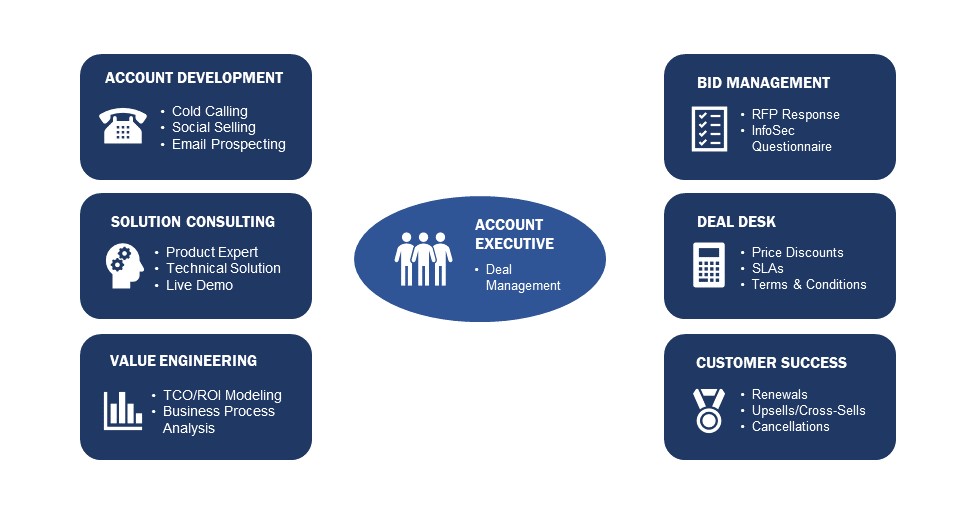Highly Specialized Functions
In my last post, I outlined how the organizational design of the modern software sales organization offloads almost every important aspect of a deal cycle from the rep to specialized functions. Account development teams generate the leads. Solution Consultants deliver the demos. Value Engineers calculate ROI. Bid Management responds to proposals. The Deal Desk negotiates pricing. And Customer Success renews contracts.

That leaves the sales representative doing almost nothing except collecting a big, fat commission check! At least, that is how it might appear.
Is this a case of sales leaders using their skills to trick the rest of the business into doing their job? Or is there a rationale for this model? It is true that the modern rep does not perform many of the activities historically associated with the sales role. Instead, today’s sales managers have their representatives focused on what they believe to be the most important aspect of winning business – managing the deal cycle. Today’s sales rep may not be a cold caller, RFP writer, product expert or price negotiator. But the modern sales rep must be a great deal manager.
The Quarterback Model
The modern sales organization is designed upon what I call the quarterback model. The organizational design of today’s software sales resembles the structure of an NFL team. In the 1980s and 1990s, the sales rep was the only one who could put points on the board. S/he needed to be a running back, a wide receiver, an offensive tackle, an extra point kicker prospecting in the assigned territory, mastering the value proposition and writing the proposal. Along with playing every position came the need to do the blocking and tackling for every issue that arose during the sales process. The problem with the historical model is that relatively few sales reps were such versatile athletes as to be good as all these different tasks. And as a result, performance of the sales reps at many companies was top-heavy. A lucky few who happened to have product expertise along with a diverse range of writing, presentation, negotiation and organizational skills were successful. While the majority of the sales team that may have only one or two of the required skills struggled to repeatedly hit their numbers.
In the modern sales organization, the sales rep is no longer playing every position on the offense. Instead, s/he just needs to be the quarterback. S/he just needs to know what plays to call and who to give the ball to. And s/he needs to know how to read the defense (i.e. the customer) to effectively win the game.

Primary and Secondary Responsibilities
The Modern Software Sales Rep
- What are the business objectives, competitive pressures and shareholder demands that the customer is responding to?
- What are the compelling events, if any, driving the timelines for the project?
- Who are the decision makers, key stakeholders and executive sponsors of the project?
- Who are the outside influencers such as management consultants, systems integrators or industry analysts that are likely to offer opinions on vendor selection?
- What is the competitive landscape of other software providers that might also be chasing the same opportunity?
- How to qualify sales opportunities and how decide which to pursue.
- When to bid on RFPs and when to pass on long shot deals the competition is better positioned to win.
- What are the key decision criteria being used to compare vendors and how to influence those criteria?
- What direction to provide account development reps to find highly qualified leads that are most likely to convert.
- How to most effectively utilize their solution consultant to help overcome feature gaps, security risks and support limitations.
- Why the value engineering team should be leveraged to make a compelling business case for change.
- When to reach beyond the sales organization to leverage skills and expertise in the product management, software engineering, customer support or the executive team.
- When, how and why to bring partners into a deal to increase the probability of success.









